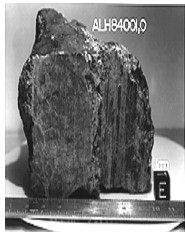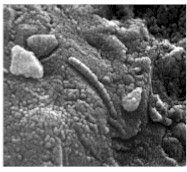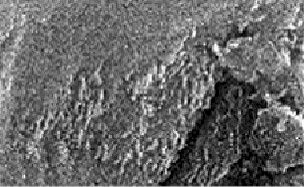|
|
|
DR. FRANÇOIS DURAND (DEPARTMENT OF ZOOLOGY, RAND AFRIKAANS UNIVERSITY, JOHANNESBURG)
Most people become interested in palaeontology and evolution by asking, ‘Where do we come from?’ Every culture, as far as I know, has an unique answer to this question. For some people it is sufficient to accept Bishop Ussher’s calculation (based on genealogical evidence from the Bible) that people were created on Friday 28 October 4004 BC, others believe, like Erich von Däniken, that we are the product, if not the descendants of extra-terrestrial beings.
Our growing knowledge of astronomy has led to the reali-zation that our sun is also a star and that statistically there must be billions upon billions of stars similar to our sun with Earth-like planets revolving around them, in the universe. The logical con-clusion that follows is that life could have evolved on these planets too. This conclusion, al-though logical, has put some people in a tight spot – take Giordano Bruno, for example. This Italian monk stated, already in the sixteenth century, that ‘Innumerable suns exist; in-numerable earths revolve around these suns in a manner similar to the way the seven planets revolve around our sun. Living beings inhabit these worlds.’ He fled from Italy in 1576 to avoid a trial on doctrinal charges and lived for several years in France and England. At the insistence of Giovanni Moncenigo, a Venetian nobleman, Bruno returned to Italy as his private tutor. In 1592 Moncenigo denounced Bruno to the Inquisition, which tried him for heresy. When Bruno refused to recant, after spending eight years in jail, he was burned at the stake in the Campo dei Fiori in Rome.
From palaeontological and geological evidence it is estima-ted that life, in the form of primitive bacteria-like organ-isms, originated on Earth approximately 3,5 billion years ago (Earth itself is approxi-mately 4,8 billion years old). Bacteria and blue-green algae are known as the Monera or Prokaryotes and do not possess nuclei or double-membrane organelles as do more complex organisms. As far as we know, Monera was the only form of life for almost three quarters of the history of life on Earth. It is not clear yet how life originated from non-living organic com-pounds. One of the most popular theories was advanced by the American chemist Stanley Miller who, in 1953, created the building blocks of life from a mixture of gases, similar to those which made up the atmosphere of ancient Earth. He managed to produce an organic soup by sending electrical sparks over-night through a mixture of methane, hydrogen and ammonia.
The fact that the organic soup contained certain life-supporting compounds such as amino acids, nucleotides, nucleo-sides and carbohydrates which normally occur in cells, was very exciting. He postulated that these compounds could have been formed in the ancient Earth atmosphere by lightning, and that it poured down and accumulated in pools. Complex self-replicating molecules could have formed in the organic soup filling these pools. Other scientists argue that these complex molecules could only have formed in boiling water such as that found in thermal springs. An interesting fact which supports this theory is that some of the most primitive bacteria on Earth, the Thermophiles, thrive in the boiling water of hot springs.
Scientists recently suggested that the ancient Earth atmosphere could have been made up of carbon dioxide and nitrogen instead of methane, hydrogen and ammonia. According to them the concentration of organic compounds, from which life arose on Earth, could have originated in outer space. Aster-oids, comets, meteorites and interplanetary dust often carry certain organic compounds in-cluding amino acids. These extraterrestrial bodies could have enriched the Earth’s surface with organic compounds over many millennia. This hypothesis might sound far-fetched until one takes the SNC or Mars meteorites in consideration.
Of the 20 000 meteorites discovered on Earth, 13 display a unique chemical profile which indicates that they have origina-ted from the planet Mars. These meteorites consist of basaltic lava which crystallized only relatively recently in the history of the solar system. The indica-tions are that they have origina-ted from a planet or planets which was or were still semi-molten approximately 1,3 billion years ago. The only two planets in our solar system which retained enough heat at that time were Mars and Venus. Gas bubbles contained within the meteorites have since proved to be identical to the Martian atmosphere.
NASA scientists caused an uproar when they announced in August 1996 that they had discovered the fossilized remains of ancient organisms in certain of the SNC meteorites. Meteorite ALH84001 was discovered in the Allan Hills Ice Field by members of the American National Scientific Foundation’s Antarctic Meteorite Programme in 1984 during their annual expedition.
It consists of a fragment of a bigger meteorite which was ripped out of the Martian crust during a massive meteorite im-pact there more than 16 million years ago. After travelling through space over millions of years, it was captured by Earth’s gravitational forces, where it eventually crashed approxi-mately 13 000 years ago. After studying ALH84001 for two years, a team of NASA scientists revealed the fact that the meteorite contains organic molecules, minerals associated with life and microscopical structures which resemble bacteria. The largest of these conjectured fossils is 1/100 of a human hair in diameter while others are ten times smaller.
Sceptical researchers argue that even if these microscopic remains are those of bacteria, it would be impossible to be sure of its origin. Jeffrey Kluger has argued that the meteorite sat on the Antarctic ice cap for 13 000 years, during which time it could have been contaminated by Earthly microbes and that the meteorite has been handled by humans afterwards for two years. The organic compounds in the meteorite could equally have come from Mars, outer space or from Earth. He also mentioned another curious possibility – namely, that ‘if we allow planetary cross-pollination from Mars to Earth, why not from Earth to Mars and back. In fact, Earth’s life forms could have originated on Mars, been trans-ported here by meteorite, and subsequently died out on Mars’.
The new Mars programme will attempt to find answers to some of these tormenting questions. Few people realize that the present and subsequent Mars missions will search for evidence of ancient, possibly extinct life, in other words, it will carry out palaeontological research. These surveys will also include the search for life-supporting resources, especially water. Because life on Earth originated in water, it could possibly be true of Martian life. Secondly, because the origin of life on Earth is so closely connected to water, we still depend on it. If water is freely available on Mars, it will broaden our choice for the placement of economically viable research stations – anywhere else but the poles.
Signs of free water can be seen nearly everywhere on the Martian surface. There is also evidence that Mars was much warmer once upon a time and that rivers and bubbling fountains were common. Old crater rims are weathered and others are scarred by gullies which could only have been carved by running water. In certain areas the Martian surface is scored by branching networks of valleys, similar to those made by river tributary systems on Earth. Free water subsequently disappeared from the Martian surface however. Water only still occurs as ice crystals in the atmosphere, and on the surface as ice on the pole caps. In the summer months the ice caps melt partially and the Martian sky is filled with clouds. But where did the water, which carved gigantic flood channels – which may be hundreds of kilometres wide and over a thousand kilometres long – from the Martian surface, disappear to? One theory is that most of this water could occur as a subterraneous layer of up to 500m thick.
Subterraneous water can also support life. Todd Stevens and Jim McKinley of the American Pacific Northwest Laboratory in Richland, Washington, have discovered bacteria in deep aquifers in basalt formations near Washington. These bacteria are the only known organisms which can survive without any energy input from the sun, geothermal warmth form the Earth’s interior or chemical energy stored in organic matter. The bacteria, which were named ‘subsurface lithoautotrophic microbial sub-systems’ or ‘SLIME’, apparently live only on rock and water. Life on Mars may resemble this.
Dan McCleese, chief scientist of the Mars Exploration Program laboratory in Pasadena, California, said that they planned to send exploration robots every 26 months (i.e., when Mars is at its optimum position to Earth) to Mars. Certain rockets will be sent up in pairs, the one with an orbiter and the other with a lander. These robots will each conduct its own set of experiments but the orbiters will also act as relay stations transmitting data back to Earth from the landers, and vice versa. The landers will also link up electronically to do joint experiments. A single lander can report on the weather at a particular spot on Mars, but a network of landers can monitor the dynamics of the planet’s climate. Similarly, a single lander’s seismometer can measure a quake, but a network of seismometers can measure the size of the planetary core.
No sign of life or organic material has been detected on the Martian surface by the Viking landers in 1976 nor by the Sojourner robots in 1997 – possibly because the Martian surface is sterile. 1999 will see the deployment of new technology which will include the use of microprobes. These 2kg probes will fall from space and will crash into the Martian surface at a speed in excess of 700km per hour. During the impact the microprobes will split into a forebody and an aftbody system. The forebody, which will be lodged into the surface at a depth of 0,3–1,9m, will contain the primary electronic sensors and instruments. The aftbody, connected to the forebody by an electrical cable, will remain close to the surface to collect meteorological data and deploy an antenna for relaying data back to Earth via the orbiters.
According to Dr John McNamee, manager of the 1998 Mars Surveyor Lander and Orbiter project at NASA’s Jet Propulsion Laboratory (JPL), Pasadena, California, this will be the most efficient and effective way of obtaining soil samples and measurements from below the sterilized Martian surface. The microprobes, together with other landing units, will continue their search for subterraneous water, minerals and signs of life. In 2005 an unmanned return mission is planned during which rock and soil samples will be collected by robots and returned to Earth to be for analysed for, among other things, signs of life.
We may finally get answers to some of our questions only within the next twenty years, when the first manned missions to Mars are planned.
It is a serious indictment of humankind that we accept new paradigms forged by science as a matter of fact, without reflecting upon the talents, initiative, diligence and sacrifices of the handful of scientists who brought it about. Nor does humankind think about the suffering it would have been subjected to if not for the activities of these people. But even worse, the man in the street does not think about his role in the persecution, humiliation and social rejection which the scientist often has to suffer. How many people gleefully took part in the proceedings when Galileo, Bruno, Columbus, Darwin or Wegener were persecuted for their views on heliocentrism, extraterrestrial life, a round Earth, evolution or continental drift, only to resignedly (and with complete amnesia about their previous prejudices) accept the new paradigm later, when its inescapable truth eventually dawned upon them? If there is intelligent life out there, what will its opinion be of us? We who persecute our intellectuals because they rip us from the cosy cave of ignorance and expose us to the thunderous, alien and uncontrollable music of the universe.

Fig. 1: Giordano Bruno, the monk burned at the stake in 1600 for, among other things, postulating the existence of extrasolar planets (statue in Rome, Campo dei Fiori, the site of his martyr-dom)

Fig. 2: Meteorite ALH84001, once part of Mars; it contains evidence which suggests that primitive life may have existed on Mars billions of years ago. (Photo: NASA)

Fig. 3: Electron microscope image showing an unusual tube-like structural form that is less than 1/100th the width of a human hair in diameter, found in meteorite ALH84001. (Photo: NASA)

Fig. 4: Electron microscope image showing tube-like structures which might be microscopic fossils of primi-tive, bacteria-like organisms that may have lived on Mars more than 3,6 billion years ago. (Photo: NASA)